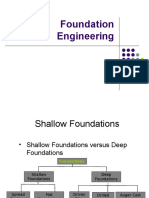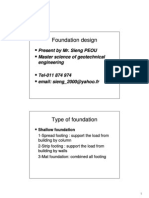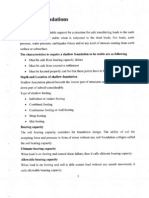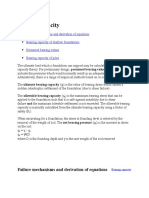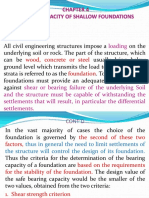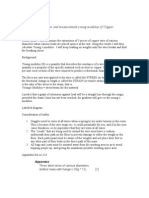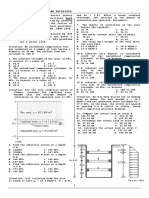CE-151-Topic-6-Soil-Bearing-Capacity (1)
CE-151-Topic-6-Soil-Bearing-Capacity (1)
Uploaded by
Jhan SeenCopyright:
Available Formats
CE-151-Topic-6-Soil-Bearing-Capacity (1)
CE-151-Topic-6-Soil-Bearing-Capacity (1)
Uploaded by
Jhan SeenCopyright
Available Formats
Share this document
Did you find this document useful?
Is this content inappropriate?
Copyright:
Available Formats
CE-151-Topic-6-Soil-Bearing-Capacity (1)
CE-151-Topic-6-Soil-Bearing-Capacity (1)
Uploaded by
Jhan SeenCopyright:
Available Formats
TOPIC 6 – Soil Bearing Capacity for Shallow Foundations
Foundations’ function is to transfer the load of the structure to the soil on which it is resting.
Depending on the structure and soil encountered, various types of foundations are used.
A spread footing is simply an enlargement
of a load-bearing wall or column that makes it
possible to spread the load of the structure over a
larger area of the soil.
In soil with low load-bearing capacity, the
size of the spread footings required is impracticably
large. In that case, it is more economical to
construct the entire structure over a concrete pad. Spread Footing
This is called a mat foundation.
Pile and drilled shaft foundations are used
for heavier structures when great depth is required
for supporting the load.
Pile foundations. Piles are structural
members made of timber, concrete, or steel that
transmit the load of the superstructure to the lower
layers of the soil. According to how they transmit Mat Foundation
their load into the subsoil, piles can be divided into
two categories: friction piles and end-bearing piles.
In the case of friction piles, the superstructure load
is resisted by the shear stresses generated along
the surface of the pile. In the end-bearing pile, the
load carried by the pile is transmitted at its tip to a
firm stratum.
Drilled Shaft foundation. In the case of
drilled shafts, a shaft is drilled into the subsoil and Pile Foundation
then is filled with concrete. A metal casing may be
used while the shaft is being drilled. The casing
may be left in place or may be withdrawn during the
placing of concrete. Generally, the diameter of a
drilled shaft is much larger than that of a pile. The
distinction between piles and drilled shafts
becomes hazy at an approximate diameter of 1 m
(3 ft), and the definitions and nomenclature are
inaccurate Drilled Shaft Foundation
CE 151 – Geotechnical Engineering II 1
Spread footings and mat foundations generally are referred to as shallow foundations. Shallow
foundations are foundations that have a depth-of-embedment to-width ratio of approximately less than four.
Pile and drilled-shaft foundations are classified as deep foundations. Deep Foundation has depth-of-
embedment-to-width ratio of greater than four.
Soil Bearing Capacity Failures
General Shear Failure
A general shear failure involves total rupture of the underlying soil. There is a continuous shear failure of
the soil (solid lines) from below the footing to the ground surface. When the load is plotted versus settlement of
the footing, there is a distinct load at which the foundation fails (solid circle), and this is designated Q ult . The
value of Q ult divided by the width Band length Lof the footing is considered to be the ultimate bearing capacity (
q ult ) of the footing. The ultimate bearing capacity has been defined as the bearing stress that causes a sudden
catastrophic failure of the foundation.
A general shear failure ruptures and pushes up the soil on both sides of the footing. For actual failures in
the field, the soil is often pushed up on only one side of the footing with subsequent tilting of the structure.
A general shear failure occurs for soils that are in a dense or hard state.
Local Shear Failure
Local shear failure involves rupture of the soil only immediately below the footing. There is soil bulging on
both sides of the footing, but the bulging is not as significant as in general shear.
Local shear failure can be considered as a transitional phase between general shear and punching
shear. Because of the transitional nature of local shear failure, the bearing capacity could be defined as the first
major nonlinearity in the load-settlement curve (open circle) or at the point where the settlement rapidly increases
(solid circle).
A local shear failure occurs for soils that are in a medium dense or firm state.
CE 151 – Geotechnical Engineering II 2
Punching Shear Failure
A punching shear failure does not develop the distinct shear surfaces associated with a general
shear failure. For punching shear, the soil outside the loaded area remains relatively uninvolved and there
is minimal movement of soil on both sides of the footing.
The process of deformation of the footing involves compression of soil directly below the footing as
well as the vertical shearing of soil around the footing perimeter.
A punching shear failure occurs for soils that are in a loose or soft state.
Terzaghi’s Ultimate Bearing Capacity Equation
Bearing capacity is the maximum pressure that the soil can support at foundation level without
failure. This is a key design parameter for foundation design and also for the design of retaining walls at the
base level.
CE 151 – Geotechnical Engineering II 3
According to Terzaghi (1943), a foundation may be defined as a shallow foundation if the depth D f
is less than or equal to its width B. He also assumed that, for ultimate soil-bearing capacity calculations, the
weight of soil above the base of the footing may be replaced by a uniform surcharge, q=γ D f .
The failure mechanism assumed by Terzaghi for determining the ultimate soil bearing capacity
(general shear failure) for a rough strip footing located at a depth D f measured from the ground surface is
shown in the figure below.
Terzaghi used an approximate method to determine the ultimate bearing capacity, q ult . The
principles of this approximation are the following: (considering a strip footing)
1. If c=0 and surcharge ( q )=0 (that is, D f =0 ¿ , then
1
q ult =q γ = γB N γ
2
2. If γ =0 (that is, weightless soil) and q=0 , then
q ult =q c =c N c
3. If ¿ 0 (weightless soil) and c=0, then
q ult =q q=q N q
By the method of superimposition, when the effects of the unit weight of soil, cohesion, and surcharge are
considered, we have
Strip Footing
1
q ult =q c + qq + qγ =c N c +q N q + γB N γ
2
The equation is referred to as Terzaghi’s bearing capacity equation. The terms N c , N q , and N γ
are called the bearing capacity factors. The values of these factors are given in the table,
CE 151 – Geotechnical Engineering II 4
Terzaghi’s Bearing Capacity Factors
Terzaghi suggested the following equations for ultimate soil-bearing capacity:
Square Footing
q ult =1.3 c N c + q N q +0.4 γB N γ
Rectangular Footing
(
q ult =c N c 1+
0.3 B
L ) (
+ q N q +0.5 γB N γ 1−
0.2 B
L )
Circular Footing
q ult =1.3 c N c + q N q +0.3 γB N γ
where:
CE 151 – Geotechnical Engineering II 5
q ult −¿ ultimate bearing capacity
c−¿ cohesion of the soil or undrained shear strength
qu
c=
2
q u−¿ unconfined compressive strength
γ −¿ unit weight of soil
q−¿ vertical effective stress at the base of the foundation
q=γ Df
N c , N q , N γ−¿ bearing capacity factors
B – width of foundation or for circular footing it is equal to its diameter
L – length of foundation
∅ −¿ angle of internal friction
FS−¿ factor of safety
Bearing Capacity Factors (if table is not given):
Reissner (1924)
(
N q =e π tan (∅) tan2 45+
∅
2 )
Prandtl (1921)
N c =( N q−1 ) cot (∅ )
Vesic (1973)
N γ =2 ( N q +1 ) tan(∅ )
Effect of Groundwater Table
Case I. If the groundwater table is located at a distance D above the bottom of the foundation, the
magnitude of q in the second term of the bearing capacity equation should be calculated as
CE 151 – Geotechnical Engineering II 6
q=γ ( Df −D ) + γ ' D
'
where γ =γ sat −γ w =¿ effective unit weight of soil. Also, the unit weight of soil, γ , that appears in the third
term of the bearing capacity equations should be replaced by γ ' .
Case II. If the groundwater table coincides with the bottom of the foundation, the magnitude of q is equal to
γD f . However, the unit weight, γ , in the third term of the bearing capacity equations should be replaced by
γ '.
Case III. When the groundwater table is at a depth D below the bottom of the foundation, q=γDf . The
magnitude of γ in the third term of the bearing capacity equations should be replaced by γ av .
CE 151 – Geotechnical Engineering II 7
1
γ av =
B
[ γD+ γ ( B−D ) ] ( for D≤ B )
'
γ av =γ ( for D> B )
Factor of Safety
Generally, a factor of safety, FS , of about 3 or more is applied to the ultimate soil-bearing capacity
to arrive at the value of the allowable bearing capacity. An FS of 3 or more is not considered too
conservative. In nature, soils are neither homogeneous nor isotropic. Much uncertainty is involved in
evaluating the basic shear strength parameters of soil.
There are two basic definitions of the allowable bearing capacity of shallow foundations. They are
gross allowable bearing capacity, and net allowable bearing capacity.
The gross allowable bearing capacity can be calculated as
qu
q all =
FS
The net allowable bearing capacity is the allowable load per unit area of the foundation in excess
of the existing vertical effective stress at the level of the foundation. The vertical effective stress at the
foundation level is equal to q=γDf . So, the net ultimate load is
q u (net )=q u−q
CE 151 – Geotechnical Engineering II 8
You might also like
- Answers For Tutorial No. 2: ME1202 Introduction To Thermodynamics - Academic Year 2017Document9 pagesAnswers For Tutorial No. 2: ME1202 Introduction To Thermodynamics - Academic Year 2017manaraj100% (1)
- One-Dimensional Motion With A Constant Acceleration LabDocument5 pagesOne-Dimensional Motion With A Constant Acceleration LabJoseph zNo ratings yet
- Bearing CapacityDocument63 pagesBearing CapacityamgadgadounNo ratings yet
- Bearing Capacity of Shallow FoundationDocument43 pagesBearing Capacity of Shallow FoundationUnnikrishnanKPNo ratings yet
- Mod 2 Bearing Capacity Jan 2022Document57 pagesMod 2 Bearing Capacity Jan 2022basiljoy787No ratings yet
- Terzaghi Si Hansen 24343261-Bearing-Capasity-OfsoilDocument46 pagesTerzaghi Si Hansen 24343261-Bearing-Capasity-OfsoilOana MateiNo ratings yet
- Shallow Foundation Gate Notes 57Document6 pagesShallow Foundation Gate Notes 57srisaikiranrelangiNo ratings yet
- Bearing Capacity of Shallow FoundationDocument46 pagesBearing Capacity of Shallow FoundationPranavaDart100% (1)
- Foundations 170731194600 PDFDocument76 pagesFoundations 170731194600 PDFBELAL ALSUBARINo ratings yet
- Lecture 03Document64 pagesLecture 03MmNo ratings yet
- CH 2 - Lecture 1. Bearing Capacity of Shallow FoundationsDocument20 pagesCH 2 - Lecture 1. Bearing Capacity of Shallow FoundationsMoneer Mohamed100% (1)
- Bearing Capasity OfsoilDocument46 pagesBearing Capasity Ofsoiltamratdugo9No ratings yet
- The Bearing Capacity of Soils: DR Omar Al HattamlehDocument64 pagesThe Bearing Capacity of Soils: DR Omar Al HattamlehHusam Adnan HamoutaNo ratings yet
- Introduction To Rock PDFDocument74 pagesIntroduction To Rock PDFrabindrachyNo ratings yet
- Soil Bearing Capacity Unit 4Document10 pagesSoil Bearing Capacity Unit 4Prince AJNo ratings yet
- Foundation Design (Compatibility Mode)Document79 pagesFoundation Design (Compatibility Mode)Khemerakh50% (2)
- Bearing Capacity - Shallow FoundationsDocument47 pagesBearing Capacity - Shallow FoundationsVuyo SigaukeNo ratings yet
- Bearing CapacityDocument70 pagesBearing CapacityhanaalnaasNo ratings yet
- 1.1 DefinitionsDocument13 pages1.1 Definitionsبه شدار ازاد عبدالرحمن عليNo ratings yet
- Shallow FoundationDocument14 pagesShallow FoundationesahjamilNo ratings yet
- Bearing Capacity 2019Document32 pagesBearing Capacity 2019Ahmed SaberNo ratings yet
- Bearing Capacity 3Document54 pagesBearing Capacity 3Elvis OduorNo ratings yet
- Bearing Capacity of Shallow FoundationDocument49 pagesBearing Capacity of Shallow FoundationMuhammad Faisal Habib JanjuaNo ratings yet
- Two Important Factors That Are To Be Considered Are:: Shallow Foundation: Ultimate Bearing Capacity Shallow FoundationDocument4 pagesTwo Important Factors That Are To Be Considered Are:: Shallow Foundation: Ultimate Bearing Capacity Shallow FoundationMaria Clarissa Joy OrdoñoNo ratings yet
- Bearing Capacity of Shallow FoundationsDocument31 pagesBearing Capacity of Shallow FoundationsDanyal AhmedNo ratings yet
- Chapter 2Document39 pagesChapter 2Zsoloa adamNo ratings yet
- Foundation DesignDocument254 pagesFoundation DesignOeng Bunhak100% (2)
- Foundation Analysis: Ultimate Bearing Capacity: Shallow FoundationDocument21 pagesFoundation Analysis: Ultimate Bearing Capacity: Shallow FoundationShiela Marie Cruz100% (1)
- Chapter 5 Bearing CapacityDocument18 pagesChapter 5 Bearing CapacityErmias MeridNo ratings yet
- Ultimate Bearing Capacity of Shallow FoundationsDocument44 pagesUltimate Bearing Capacity of Shallow FoundationsMaria Vencentcia100% (2)
- Kuliah 5 PASCA SARJANA 2019 - 2020 GANJIL UBDDocument115 pagesKuliah 5 PASCA SARJANA 2019 - 2020 GANJIL UBDDr. S. K. Nava NavaratnarajahNo ratings yet
- 10 - Soil Bearing Capacity of SoilsDocument18 pages10 - Soil Bearing Capacity of Soilsfabiaclarence89No ratings yet
- Bearing Capacity-Shallow FoundationDocument31 pagesBearing Capacity-Shallow FoundationTamour KhalilNo ratings yet
- BEARING CAPASITY OFSOIL FinalDocument41 pagesBEARING CAPASITY OFSOIL FinalAysha RasheedNo ratings yet
- Calculate Bearing CapacityDocument69 pagesCalculate Bearing Capacityoliver.loridoNo ratings yet
- Bearing Capacity PDFDocument13 pagesBearing Capacity PDFChoun OleNo ratings yet
- Shallow Foundation PDFDocument75 pagesShallow Foundation PDFSweet BoyNo ratings yet
- Chapter2 2011Document200 pagesChapter2 2011Abdelrahman Omar HindiNo ratings yet
- Bearing Capacity From SPT Numbers PDFDocument22 pagesBearing Capacity From SPT Numbers PDFKA25 Consultant100% (1)
- Chapter Three: Bearing Capacity of Soils (Shallow Foundations)Document15 pagesChapter Three: Bearing Capacity of Soils (Shallow Foundations)Wubetie MengistNo ratings yet
- Chapter-2-Review of Bearing CapacityDocument31 pagesChapter-2-Review of Bearing Capacityznabu asefaNo ratings yet
- مشاكل تنفيذ البيارات فى SOFT CLAYDocument9 pagesمشاكل تنفيذ البيارات فى SOFT CLAYamrmahdy.ayoubNo ratings yet
- Foundation Designs.Document26 pagesFoundation Designs.Shijumon KpNo ratings yet
- Chapter 13 Shallow Foundation Fi 16Document10 pagesChapter 13 Shallow Foundation Fi 16Shaik Mastan ValiNo ratings yet
- Lecture-2 Bearing Capacity of SoilDocument57 pagesLecture-2 Bearing Capacity of SoilolibiraNo ratings yet
- Chapter-Ii-Bearing Capacity of Foundation SoilDocument24 pagesChapter-Ii-Bearing Capacity of Foundation Soilabyalew b.No ratings yet
- Bearing CapacityDocument77 pagesBearing CapacitySheikh Muneeb100% (1)
- Ch1 IntroductionDocument13 pagesCh1 Introductionريام الموسويNo ratings yet
- 3 Bearing Capacity Part1Document56 pages3 Bearing Capacity Part1Haider Yousef0% (1)
- Terzaghis Bearing CapacityDocument3 pagesTerzaghis Bearing CapacityDupio German IINo ratings yet
- Analysis of FoundationDocument91 pagesAnalysis of FoundationLinoNo ratings yet
- Chapter 4Document140 pagesChapter 4Solomon MehariNo ratings yet
- Geotechnical PDFDocument150 pagesGeotechnical PDFDalia Sultana MouriNo ratings yet
- Sembodai Rukmani Varatharajan Engineering College: Department of Civil EngineeringDocument19 pagesSembodai Rukmani Varatharajan Engineering College: Department of Civil EngineeringbaizubirajiNo ratings yet
- CE455 Foundation and Earth Design: Dr. Hatem GasmiDocument53 pagesCE455 Foundation and Earth Design: Dr. Hatem Gasmimedo eidNo ratings yet
- Bearing CapacityDocument6 pagesBearing CapacityYarid Poma CastellanosNo ratings yet
- I Chapter Two Bearing Capacity of Soil: Foundation Engineering CourseDocument39 pagesI Chapter Two Bearing Capacity of Soil: Foundation Engineering Coursearno assassinNo ratings yet
- Module 2 GT IIDocument7 pagesModule 2 GT IIirfanalict01No ratings yet
- Session 5 - 6 Bearing Capacity of Shallow Foundation: Course: S0484/Foundation Engineering Year: 2007: 1/0Document41 pagesSession 5 - 6 Bearing Capacity of Shallow Foundation: Course: S0484/Foundation Engineering Year: 2007: 1/0rasputin0780803494No ratings yet
- Pressure, Resistance, and Stability of Earth American Society of Civil Engineers: Transactions, Paper No. 1174, Volume LXX, December 1910From EverandPressure, Resistance, and Stability of Earth American Society of Civil Engineers: Transactions, Paper No. 1174, Volume LXX, December 1910No ratings yet
- Youngs ModDocument10 pagesYoungs ModgjosephidesNo ratings yet
- 2206 8MA0-22 AS level Mechanics - June 2022 mark scheme (student-friendly)Document5 pages2206 8MA0-22 AS level Mechanics - June 2022 mark scheme (student-friendly)Sahar QuadriNo ratings yet
- 4 Oscillations PDFDocument6 pages4 Oscillations PDFdgkulkarniNo ratings yet
- Forging Analysis - 1: Prof. Ramesh Singh, Notes by Dr. Singh/ Dr. ColtonDocument43 pagesForging Analysis - 1: Prof. Ramesh Singh, Notes by Dr. Singh/ Dr. ColtonsarvntpcNo ratings yet
- Considerations On The Stability of Nonlinear Systems. Part Ii: Jump Resonance PhenomenaDocument4 pagesConsiderations On The Stability of Nonlinear Systems. Part Ii: Jump Resonance Phenomenajai dNo ratings yet
- Feedback Control For Course Correction of A Spin Stabilized ProjectileDocument114 pagesFeedback Control For Course Correction of A Spin Stabilized ProjectileG RajeshNo ratings yet
- Shear Buckling of Ship Plates With Different HolesDocument10 pagesShear Buckling of Ship Plates With Different Holes7qzytrxdrhNo ratings yet
- Study On Average Nusselt and Sherwood Numbers in Vertical Plate Channels With Falling Water Film EvaporationDocument6 pagesStudy On Average Nusselt and Sherwood Numbers in Vertical Plate Channels With Falling Water Film EvaporationKelly RamosNo ratings yet
- Waves and em Spectrum WsDocument2 pagesWaves and em Spectrum WsTracey LaRussoNo ratings yet
- Performance Analysis of Non Linear Jacke d4b8231c PDFDocument7 pagesPerformance Analysis of Non Linear Jacke d4b8231c PDFAKBAR KRISNANo ratings yet
- Refresher GEO Part1Document2 pagesRefresher GEO Part1Lionel LapuzNo ratings yet
- Lecture 3Document17 pagesLecture 3Azeezan AlessaNo ratings yet
- Statically Indeterminate Structures by The Matrix Force Method-3 PDFDocument14 pagesStatically Indeterminate Structures by The Matrix Force Method-3 PDFmathewsujith31No ratings yet
- assignment 1 2018 - 合并Document35 pagesassignment 1 2018 - 合并sheen19970626No ratings yet
- Simple MachinesDocument15 pagesSimple MachinesMHNo ratings yet
- Modified Slant Shear Test To Enforce Adhesive Failure: July 2012Document12 pagesModified Slant Shear Test To Enforce Adhesive Failure: July 2012Aditya CaesarNo ratings yet
- Answers Chapter 13 and 14 Physics MCDocument7 pagesAnswers Chapter 13 and 14 Physics MCmike100% (1)
- Lab Report Mechanical Equivalent of HeatDocument5 pagesLab Report Mechanical Equivalent of HeatSalam Albaradie89% (9)
- Bending DiesDocument31 pagesBending DiesTamirat Nemomsa100% (1)
- Wa0002.Document6 pagesWa0002.gemwinsyzNo ratings yet
- Vibration Signature AnalysisDocument16 pagesVibration Signature Analysisabolfazlkhaki100% (1)
- WS - 6 DT PreparationDocument4 pagesWS - 6 DT PreparationNathanael Anthony Haposan PasaribuNo ratings yet
- Review Notes & Sample Problems (Thermal Stress)Document49 pagesReview Notes & Sample Problems (Thermal Stress)Pamela Rose MontecilloNo ratings yet
- Mechanics Sample ExamDocument6 pagesMechanics Sample ExamXuetong YanNo ratings yet
- Stress Analysis CEPDocument16 pagesStress Analysis CEPAbdul KarimNo ratings yet
- Momen & KopelDocument18 pagesMomen & Kopeljason wuNo ratings yet
- A Comparison of Models For Ductile Fracture Prediction in Forging ProcessesDocument8 pagesA Comparison of Models For Ductile Fracture Prediction in Forging ProcessesIndranil BhattacharyyaNo ratings yet
- Unit 8 Biomechanics & SportsDocument5 pagesUnit 8 Biomechanics & SportsDeanne Joe JohnsonNo ratings yet









